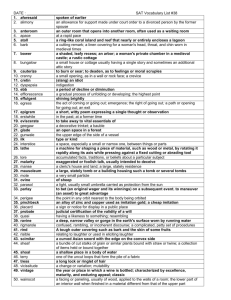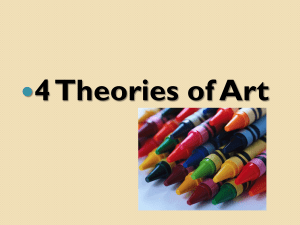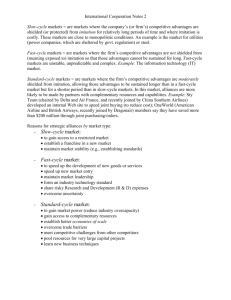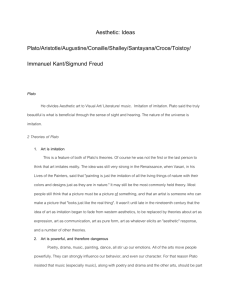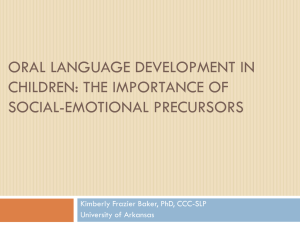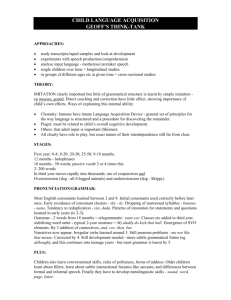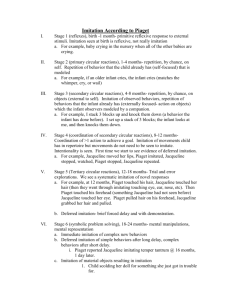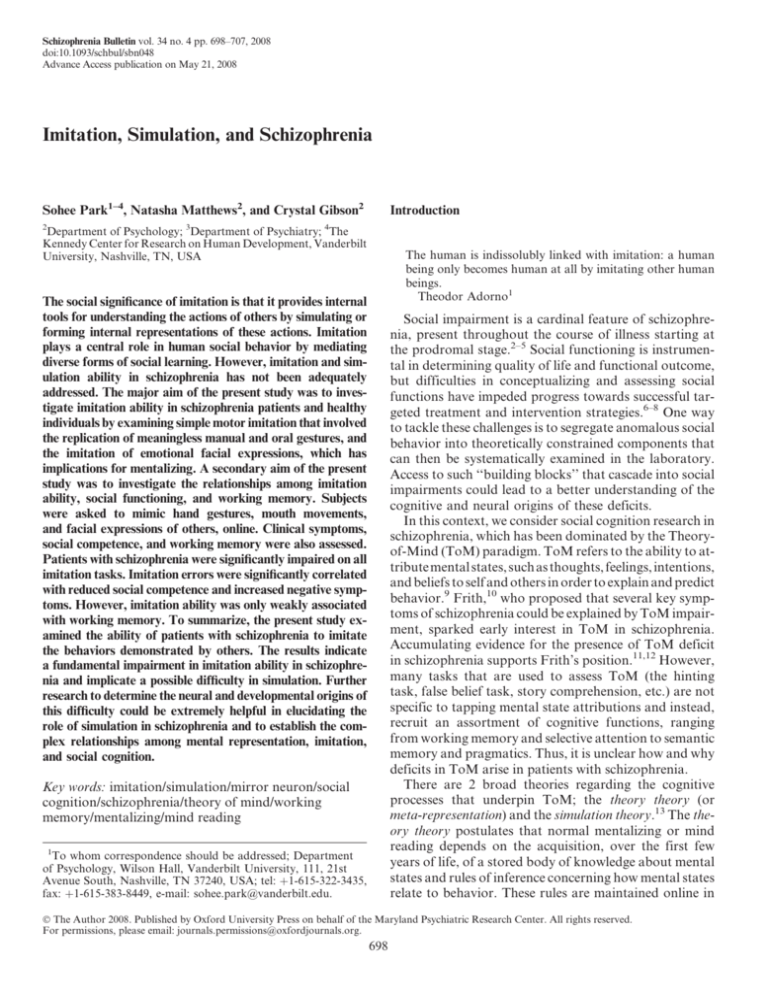
Schizophrenia Bulletin vol. 34 no. 4 pp. 698–707, 2008
doi:10.1093/schbul/sbn048
Advance Access publication on May 21, 2008
Imitation, Simulation, and Schizophrenia
Sohee Park1–4, Natasha Matthews2, and Crystal Gibson2
2
3
Introduction
4
Department of Psychology; Department of Psychiatry; The
Kennedy Center for Research on Human Development, Vanderbilt
University, Nashville, TN, USA
The human is indissolubly linked with imitation: a human
being only becomes human at all by imitating other human
beings.
Theodor Adorno1
The social significance of imitation is that it provides internal
tools for understanding the actions of others by simulating or
forming internal representations of these actions. Imitation
plays a central role in human social behavior by mediating
diverse forms of social learning. However, imitation and simulation ability in schizophrenia has not been adequately
addressed. The major aim of the present study was to investigate imitation ability in schizophrenia patients and healthy
individuals by examining simple motor imitation that involved
the replication of meaningless manual and oral gestures, and
the imitation of emotional facial expressions, which has
implications for mentalizing. A secondary aim of the present
study was to investigate the relationships among imitation
ability, social functioning, and working memory. Subjects
were asked to mimic hand gestures, mouth movements,
and facial expressions of others, online. Clinical symptoms,
social competence, and working memory were also assessed.
Patients with schizophrenia were significantly impaired on all
imitation tasks. Imitation errors were significantly correlated
with reduced social competence and increased negative symptoms. However, imitation ability was only weakly associated
with working memory. To summarize, the present study examined the ability of patients with schizophrenia to imitate
the behaviors demonstrated by others. The results indicate
a fundamental impairment in imitation ability in schizophrenia and implicate a possible difficulty in simulation. Further
research to determine the neural and developmental origins of
this difficulty could be extremely helpful in elucidating the
role of simulation in schizophrenia and to establish the complex relationships among mental representation, imitation,
and social cognition.
Social impairment is a cardinal feature of schizophrenia, present throughout the course of illness starting at
the prodromal stage.2–5 Social functioning is instrumental in determining quality of life and functional outcome,
but difficulties in conceptualizing and assessing social
functions have impeded progress towards successful targeted treatment and intervention strategies.6–8 One way
to tackle these challenges is to segregate anomalous social
behavior into theoretically constrained components that
can then be systematically examined in the laboratory.
Access to such ‘‘building blocks’’ that cascade into social
impairments could lead to a better understanding of the
cognitive and neural origins of these deficits.
In this context, we consider social cognition research in
schizophrenia, which has been dominated by the Theoryof-Mind (ToM) paradigm. ToM refers to the ability to attribute mental states, such as thoughts, feelings, intentions,
and beliefs to self and others in order to explain and predict
behavior.9 Frith,10 who proposed that several key symptoms of schizophrenia could be explained by ToM impairment, sparked early interest in ToM in schizophrenia.
Accumulating evidence for the presence of ToM deficit
in schizophrenia supports Frith’s position.11,12 However,
many tasks that are used to assess ToM (the hinting
task, false belief task, story comprehension, etc.) are not
specific to tapping mental state attributions and instead,
recruit an assortment of cognitive functions, ranging
from working memory and selective attention to semantic
memory and pragmatics. Thus, it is unclear how and why
deficits in ToM arise in patients with schizophrenia.
There are 2 broad theories regarding the cognitive
processes that underpin ToM; the theory theory (or
meta-representation) and the simulation theory.13 The theory theory postulates that normal mentalizing or mind
reading depends on the acquisition, over the first few
years of life, of a stored body of knowledge about mental
states and rules of inference concerning how mental states
relate to behavior. These rules are maintained online in
Key words: imitation/simulation/mirror neuron/social
cognition/schizophrenia/theory of mind/working
memory/mentalizing/mind reading
1
To whom correspondence should be addressed; Department
of Psychology, Wilson Hall, Vanderbilt University, 111, 21st
Avenue South, Nashville, TN 37240, USA; tel: þ1-615-322-3435,
fax: þ1-615-383-8449, e-mail: sohee.park@vanderbilt.edu.
Ó The Author 2008. Published by Oxford University Press on behalf of the Maryland Psychiatric Research Center. All rights reserved.
For permissions, please email: journals.permissions@oxfordjournals.org.
698
Imitation, Simulation, and Schizophrenia
order to reason about the actions of others.14,15 Thus,
according to the theory theory, how we infer about the
mental states of others is similar to how scientists go
about testing their hypotheses.
In contrast, the simulation theory proposes that normal
mentalizing or ‘‘mind reading’’ involves internally modeling the observed behaviors of others. It is a process of
mentally ‘‘stepping into the shoes’’ of another person.13,16
By generating an internal simulation, one can model the
thoughts, emotions, and intentions behind the behaviors
of others. In its strongest form, the simulation account
implies that understanding others’ minds requires no
meta-representation or theory formulation.
The theory theory and simulation theory of mentalizing
do not have to be mutually exclusive. It is possible that
both are employed, depending on the nature of the problem to be solved. Imagine being shipwrecked on a tropical
island with no previous exposure to the language and culture of the indigenous people. How does one attempt to
understand the actions and behaviors of the hosts?
According to the theory theory, one could apply previously acquired knowledge about one’s own culture,
and because there are many universals among our species, some of these attempts will yield fruitful mind reading results. However, such application of top-down
strategy may not be as successful for culturally unique
repertoires of behavior. When one encounters a completely novel behavior or action, which does not fit
into any previously acquired database of knowledge,
then simulation may provide an internal model, which
then can be used as an input for a theory about that behavior. Thus, the nature and the context of the social interaction would influence the interaction between the
top-down strategy exemplified by the theory-theory account and the more bottom-up strategy of simulation.
In the case of schizophrenia, neither the theory theory
nor the simulation theory has been fully explored to link
them to the behaviors of schizophrenia patients. Does the
theory theory account explain experimental findings and
clinical observations in schizophrenia with respect to social cognition? Schizophrenia patients do not necessarily
lack the conceptual knowledge about mental states, and
many patients acknowledge that beliefs can be false. This
suggests that individuals with schizophrenia are able to
use meta-representation.17
Furthermore, individuals with schizophrenia who have
difficulties in appreciating the belief of other people also
find it difficult to simulate other visual perspectives.17
The most parsimonious explanation for these co-occurring
deficits is that people with schizophrenia find it difficult
to simulate another person’s subjective experience,
whether the content of that experience is cognitive, perceptual, or affective.17 With respect to the simulation theory of mentalizing, it has been largely overlooked in
schizophrenia research yet the construct of simulation
overlaps with a fundamental cognitive function, working
memory, which may be a core feature of schizophrenia.
Individuals with schizophrenia have deficits in the maintenance and manipulation of internal representations in
working memory and an associated difficulty in using
these representations to guide behavior.18–20 Mental simulation may be described as a process by which internal
representations of external events such as movements and
actions of others are generated and maintained. Viewed
in this way, working memory and simulation share similar constructs. They both depend on the generation,
maintenance, and manipulation of internal representation. Given the widespread deficits in working memory
in schizophrenia, one would expect simulation to be
also affected. Simulation provides one possible mechanism by which we model behaviors of others, and deficits
in mental simulation could lead to misunderstanding of
actions of others. However, simulation ability in schizophrenia has not been adequately studied to date.
A simple and practical way of studying simulation experimentally is to utilize imitation. The simulation theory
of ToM simply argues that humans understand the
actions of others by replicating or mimicking other individuals. In other words, simulation of others’ mental
states requires the generation of internal representations,
and thus, it is a form of mental imitation.21
In its most generic sense of the word, imitation is the
copying of the actions of someone else. As Thorndike22
stated succinctly, imitation is ‘‘learning to do an act from
seeing it done.’’ It follows that there is a causal relationship between observing the movement or behavior
of a model and reproducing that specific movement by
imitation.23
Imitation plays a central role in human social behavior13 by mediating diverse forms of social learning.24,25
Whether learning to tango in Buenos Aires or to bow fittingly to elderly ladies in Seoul, replicating actions demonstrated by others lies at the heart of skill acquisition.
Analogous to imitation of movements, mental imitation
or simulation of behaviors of others is suggested to be
a core component of mind reading.21 Overall, a substantive body of literature indicates the importance of imitation in social learning and in the development of the
ToM.13 Thus, it is not surprising to find autism-specific
deficits in a broad range of imitation tasks, including
imitation of meaningless gestures and emotional expressions, as well as symbolic movements, which are
not caused by problems in visual memory or motor
control.26–28
The biological and social significance of imitation is
that it provides internal tools for understanding the
actions of others by simulating or forming internal representations of these actions. Evidence suggests that there
is a strong link between the simulation function required
for imitation and ToM.29 Further support for the relationship between the process of simulation and imitation
comes from investigations into the neural correlates of
699
S. Park et al.
these functions. The discovery of mirror neurons30–32 in
the premotor cortex (F5) of nonhuman primates and
their role in action understanding provide insight into
the neural mechanism supporting mental simulation in
imitation. The term mirror neurons was coined to reflect
their functional property; they are active both during the
execution of one’s own goal-directed action and during
the observation of the same action performed by
others31,32. Analogous to the mirror neurons in the monkey premotor cortex that support action understanding,
the human mirror mechanism33 is mediated by a direct
mapping of the observed action and its motor representation in the neural circuit that includes the inferior frontal gyrus (IFG) within Broca’s area (human homolog of
F5) and the right posterior parietal cortex.34 Evidence
suggests that the human mirror mechanism is also involved in simulating the thoughts, intentions, and emotions of others. A recent fMRI experiment that
investigated the neural correlates of empathy found increased activation of the neural circuits that include
the IFG and right PP during observation and imitation
of facial emotional expressions, which suggests that the
mirror mechanism is involved in empathy.35
Given the deficits in ToM ability in schizophrenia and
the close relationship between ToM and imitation ability,
it would seem reasonable to hypothesize that individuals
with schizophrenia also show imitation deficits. However, very little research has been conducted on this topic.
There is some evidence from emotion processing studies
which suggests that individuals with schizophrenia have
impairments in their ability to pose emotional expressions,36 and one recent study37 has explicitly investigated
emotional facial imitation ability in schizophrenia and
found reduced accuracy in imitation in the absence of
deficits in the identification of all emotional facial expressions. Although these findings suggest that patients with
schizophrenia are impaired in imitating emotional expressions of others, they did not address the question
of whether imitation ability itself is problematic. In other
words, do patients with schizophrenia have deficits in imitation even if the action or movement generated by the
model is simple and meaningless?
The present study was conceived to examine 3 modes
of imitation in schizophrenia patients and healthy individuals: the imitation of hand gestures, mouth movements, and emotional facial expressions. These
imitation tasks belong to 2 categories. Complex imitation,
such as emotional face imitation is related to mental state
attributions and has implications for mentalizing. Simple
imitation, such as hand and mouth imitation that involve
the replication of meaningless and disembodied manual
and oral gestures, do not require the observer to engage in
mentalizing.
Based on the results of Schwartz and colleagues37, impairment in facial expression imitation in schizophrenia
may be predicted. However, the investigation of simple
700
imitation of meaningless movements is necessary to determine whether the basic cognitive ability to imitate
and simulate is intact in schizophrenia. If there exists
a fundamental impairment in the process of simulation
in schizophrenia, then deficits should be observed in
schizophrenia for all forms of imitation.
A secondary aim of the present study was to investigate
the relationship between imitation ability and social functioning to explore if impaired imitation might be associated with difficulties in social behavior. Lastly, the
relationship between simulation ability as probed by imitation tasks and the ability to generate and manipulate
mental representations in working memory was investigated, motivated by the notion that both simulation
and working memory functions require generation and
maintenance of mental representations and are supported by overlapping neural circuits. It has been hypothesized that the core deficit in schizophrenia is an
impairment of working memory or guidance of behavior
by internal representation.18–20 It is possible that social
deficits such as impairments in imitation and cognitive
deficits such as working memory abnormalities share
common roots in problems in generating and simulating
the external world.
Method
Participants
Twenty schizophrenia outpatients (7 women) were recruited from 2 outpatient psychiatric facilities in Nashville,
TN. Diagnoses were made according to Diagnostic and
Statistical Manual of Mental Disorders, Fourth Edition
(DSM-IV) criteria38 using structured clinical interviews
(SCID-IV). All patients were taking atypical antipsychotic medications. The mean chlorpromazine (CPZ)
equivalent dose was 297.3 mg (SD = 128.1). Sixteen
healthy control subjects (9 women) without a history
of DSM-IV Axis 1 disorders in themselves or their
families were recruited from the same urban area. Schizophrenia patients (SZ) and controls (CO) were matched
for age, education, intelligence, and handedness (see
table 1). Exclusion criteria were substance use, neurological disorders, and history of head injury. All subjects had
normal or corrected-to-normal vision. All subjects gave
written informed consent approved by the Vanderbilt
University Institutional Review Board and were paid.
Design and Procedure
Clinical and Demographic Measures
Subjects were asked to complete questionnaires and participate in behavioral tasks. Symptoms ratings for SZ
were obtained on the same day using the Brief Psychiatric
Rating Scale39 (BPRS), the Scale for the Assessment
of Positive Symptoms40 (SAPS), and the Scale for the
Imitation, Simulation, and Schizophrenia
Table 1. Demographic and Clinical Variables
Age
Year of education
Edinburgh handedness
Full scale IQ
Zigler social competence
BPRS
SAPS
SANS
Schizophrenia
Patients
Healthy
Controls
38.6
14.2
60.2
99.1
3.45
18.0
15.8
15.2
37.9
14.3
73.7
96.2
5.94
—
—
—
(10.3)
(2.8)
(42.0)
(17.2)
(1.2)
(9.9)
(16.5)
(12.0)
(8.6)
(2.5)
(45.2)
(11.7)
(1.5)
Note: BPRS, Brief Psychiatric Rating Scale; SAPS, Scale for the
Assessment of Positive Symptoms; SANS, Scale for the
Assessment of Negative Symptoms.
Assessment of Negative Symptoms41 (SANS). For all
subjects, social competence was estimated by the Zigler
Social Competence Scale,42 which is based on demographic factors such as age, education, employment,
and marital status. The Zigler score can range from
0 to 8 with higher scores indicating greater social competence. Intelligence was assessed using the Wechsler Abbreviated Scale of Intelligence.43 Handedness was
assessed using the Modified Edinburgh Handedness Inventory44 (see table 1).
Working Memory
Verbal working memory (VWM) span was measured using the Letter Number Sequencing task.45 Subjects were
verbally presented a series of letters and numbers and
asked to report back the numbers in numerical order, followed by the letters in alphabetical order.
Simple Imitation
Subjects participated in 2 tasks of simple imitation, one
involving hand gestures (see figure 1a) and the other
mouth movements (see figure 1b). All participants
were given explicit instructions to copy and imitate the
movements of the ‘‘model’’ as they were watching the
stimulus presentation online. They were asked to be as
accurate as possible and were given a block of practice
trials before starting each imitation task to ensure that
they understood the task.
In the hand imitation task, subjects were shown images
of a hand forming letters of the alphabet from the American Sign Language (ASL). No participant had prior
knowledge of the ASL. Each trial began with a blank
screen. When subjects were ready to begin a trial, they
pressed the spacebar. Then 2 gestures (ie, 2 ASL letters)
appeared on the screen sequentially for 1 s each. Subjects
were instructed to imitate each gesture online while they
were observing the stimuli. This was followed by a rest
period of 10 s. During imitation, each response was compared with the presented stimulus and scored as correct
Fig. 1. The Procedure for the 3 Imitation Tasks. (a) Hand movement
imitation task. (b) Mouth movement imitation task. (c) Emotional
face imitation and identification task.
(scoring 1) or incorrect (scoring zero) by a trained experimenter who sat next to the subject with a preprinted
scoring form. The imitated gesture was required to be
a precise copy of the stimulus gesture (ie, a correct
ASL sign); all 5 fingers had to be correctly positioned
to receive the correct score for a sign. As each trial consisted of 2 ASL signs, the maximum score for a trial was 2
and the minimum score was 0. There were 2 blocks of 30
trials, one for the left and one for the right hand. The reliability of scoring was established in a separate session
with 3 independent raters judging the task performance
by 2 individuals (1 male and 1 female), who were not subjects in this study and who imitated the entire stimulus
set. The intraclass correlation coefficient was 0.92.
For the mouth imitation task, stimuli were created
from video clips of a person producing binary combinations of the English vowels, A, E, I, O, and U (eg, AE, OI,
UA, IA). Only the mouth region of the face was presented
to the subjects to ensure that they were focusing on that
part of the face. During practice trials, subjects watched
the video with the sound on and were asked to imitate
the mouth to produce the same sounds. The vowel
sounds are correctly produced only if the mouth moves
701
S. Park et al.
appropriately. After practice trials, the sound was
switched off. Subjects were instructed to move their
mouths as they watched the silent video clip and to produce the corresponding vowel sounds. Each trial began
with a blank screen. When subjects were ready to begin
a trial, they pressed the spacebar. As shown in figure 1b,
a video clip was presented of a person moving her mouth
to form 2 vowel sounds one after the other. Each mouth
movement corresponding to a single vowel sound was
presented for 1 s. Therefore each trial lasted 2 s. Subjects
moved their mouths to pronounce the 2 vowel sounds as
they were watching the video clip. Then there was a 10-s
rest period. There were 30 trials. The responses were
scored as correct (score of 1) if subjects accurately replicated the mouth movements, accompanied by the correct
vowel sound, and incorrect (score of 0) if the mouth and
the vowel sound did not match the stimulus. As each trial
consisted of 2 mouth movements, the maximum score for
a trial was 2 and the minimum score was 0. An experimenter sat next to the subject during the task and scored
the response as correct or incorrect on a preprinted scoring form. The reliability of scoring was established in a
separate session with 3 independent raters judging the
task performance by 2 individuals (1 male and 1 female)
who were not subjects in this study and who imitated
the entire stimulus set of mouth movements for vowel
pronunciations. The intraclass correlation coefficient
was 0.64.
Complex Imitation
Subjects were asked to mimic facial expressions (see figure
1c) and to identify the emotion expressed by the stimulus faces. A block of practice trials was given before
the experiment began. For the facial emotion imitation
and emotion identification tasks, stimuli were photographs of faces chosen from the Karolinska Directed
Emotional Faces.46 Seven emotions (angry, afraid,
happy, sad, surprise, disgust, and neutral) were represented by each face. There were 8 male and 8 female stimulus faces. Each trial began with a blank screen. When
subjects were ready, they pressed the spacebar. As shown
in figure 1c, a stimulus face was presented and subjects
were instructed to accurately mimic the facial expression
as they were viewing the stimulus face. The stimulus
remained on the screen until subjects finished imitating
the facial expression. Immediately following imitation,
subjects were asked to identify the emotion expressed
by the stimulus face by choosing from 7 emotions: anger,
fear, happiness, sadness, surprise, disgust, and no emotion (neutral). This was followed by a 10-s resting period.
A trained experimenter sat with the subject and scored
each face imitation as correct (2 points), partially correct
(1 point), or incorrect (0 point) on a preprinted scoring
sheet for each trial. The reliability of scoring was established in a separate session with 3 independent raters
judging the task performance by 2 participants (1 male
702
and 1 female) who were not subjects in this study and
who imitated the entire set of face stimuli. The intraclass
correlation coefficient was 0.83. There were 112 trials.
The order of presentation of the hand, mouth, and face
tasks was counterbalanced across subjects.
Results
For each task, the accuracy (% correct) was computed.
Imitation accuracy on the hand, mouth, and emotional
face imitation tasks and the identification accuracy of
emotional expression were compared between SZ and
CO with analyses of variance (ANOVAs). In addition,
correlations were computed to examine the relationships
among the imitation ability, clinical symptoms, social
competence, and VWM. All significance tests were 2
tailed unless otherwise stated.
Simple Imitation
The accuracy of performance of SZ on the hand imitation
task was compared with CO using a mixed model
ANOVA with hand (left, right) as the within-subjects factor and group (SZ, CO) as the between-subjects factor.
This analysis revealed a significant main effect of group,
with CO (M = 84.1, SD = 8.4) performing more accurately
than SZ (M = 66.4, SD = 12.4), (F(1, 34) = 23.68, P < .001)
(see figure 2). There was no significant main effect of
hand (F (1, 34) = 0.085, P = .77) and no significant
hand-by-group interactions (F (1, 34) = 0.93, P = .34),
with CO performing more accurately than SZ for both
left- and right-hand gestures. As shown in figure 2, CO
(M = 85.1, SD = 9.3) also performed more accurately
on the mouth imitation task compared with SZ (M =
70.3, SD = 12.8) (F (1, 34) = 14.9, P = .005).
Complex (Emotional Face) Imitation and Identification
The accuracy of performance of SZ on the emotional face
imitation task was compared with CO using a mixed
model ANOVA with emotion type (angry, happy, sad, surprised, afraid, disgust, and neutral) as the within-subjects
factor and group (schizophrenia, controls) as the between-subjects factor. This analysis revealed a significant
main effect of group, with CO (M = 79.4, SD = 7.9) more
accurate than SZ (M = 62.9, SD = 9.3) (F (1, 34) = 32.0,
P < .001) (see figure 2). There were no significant main
effects of emotion type (F (6, 204) = 0.94, P = .46) and no
significant emotion-by-group interaction (F (6, 204) =
0.51, P = .77). Performance of SZ and CO on the emotional identification task was also compared using a mixed
model ANOVA with emotion type (angry, happy, sad,
surprised, afraid, disgust, and neutral) as the withinsubjects factor and group (schizophrenia, controls) as
the between-subjects factor. There were no significant
differences between SZ (M = 75.9, SD = 7.9) and CO
(M = 76.9, SD = 6.7) for identification of emotion
Imitation, Simulation, and Schizophrenia
mance on the identification of emotional faces (r(16) =
0.21, P = .43).
Relation to Working Memory
Fig. 2. Accuracy (% Correct) of Schizophrenia Patients and Healthy
Control Participants on the 3 Imitation Tasks.
(F (1, 34) = 0.12, P = .73; see figure 2 and figure 3) and no
significant emotion-by-group interaction (F (6, 204) =
1.73, P = .14). There was however a significant main effect
of emotional valence (F (6, 204) = 53.25, P < .001) with
identification performance for sad, disgust, and afraid
emotions significantly lower than that for neutral, happy,
surprise, and angry emotions. A correlation was performed between the scores on the emotional identification and emotional imitation tasks to investigate the
relationship between emotion identification and imitation ability. The correlation between emotional face identification and emotional face imitation across the 2
groups was not statistically significant but there appears
to be a trend (r(36) = 0.30, P = .08). Within SZ, the correlation between emotional face imitation and identification was not statistically significant but there was a trend
(r(20) = 0.421, P = .07). Within CO, there was no correlation between the imitation accuracy and the perfor-
Although there was no statistically significant difference
in VWM span (F(1, 34) = 2.92, P = .09) between SZ (M =
5.3, SD = 1.2) and CO (M = 5.9, SD = 0.8), there appears
to be a trend toward SZ displaying reduced VWM span
compared with CO. Correlations between VWM span
and accuracy on the 3 imitation tasks and that between
VWM span and performance on the emotional identification task were examined across the 2 groups and within
each group (see table 2 for a summary of the correlations). Correlations were performed on the total hand imitation score (collapsed across hands) and on the total
emotional face imitation, and emotional face identification scores (collapsed across the 7 types of emotions).
Across the 2 groups, although the correlation was not statistically significant, there was a trend toward an association between hand imitation accuracy and VWM. In
addition, there was a significant correlation between
emotion identification accuracy and VWM across the
2 groups; increased accuracy was associated with greater
WM span. Within the SZ group, there were no significant
correlations among VWM and imitation or identification
accuracy. Within CO, there were no significant correlations among VWM and imitation accuracy, but there
was a trend toward significant correlation between
VWM and emotion identification accuracy, with increased identification accuracy associated with increased
WM span (see table 2).
Relation to Social Competence Measure
Accuracy on the imitation tasks and the emotion identification task were correlated with the Zigler Social Competence Scores across the 2 groups and within the CO and
SZ groups separately. Across the 2 groups, social competence was significantly correlated with hand imitation,
Fig. 3. Accuracy (% Correct) of Schizophrenia Patients and Healthy Control Participants on the Emotional Face Imitation and Identification
Tasks.
703
S. Park et al.
Table 2. Correlations Among the Performance on Imitation and Emotional Identification Tasks and VWM and Zigler Scores
VWM Span
Hand imitation
Mouth imitation
Emotional face
imitation
Emotional face
identification
Zigler Social Competence
All Subjects
CO
SZ
All Subjects
CO
SZ
0.32þ
0.20
0.16
0.13
0.11
0.36
0.21
0.12
0.093
0.42*
0.49**
0.55**
0.19
0.15
0.07
0.08
0.23
0.21
0.31
0.57*
0.37*
0.45þ
0.41
0.46*
Note: Correlations are presented both collapsed across groups and for the within CO and SZ groups separately. VWM, verbal working
memory; CO, control; SZ, schizophrenia patients.*P < .05, **P < .01, and þ trend level P <. 09.
mouth imitation, emotional face imitation, and emotional face identification, with higher social competence
associated with great imitation and emotion identification accuracy. There were no correlations between the
Zigler score and the performance on the imitation or
identification tasks in the CO group; however, a significant correlation between social competence and emotional identification was observed in SZ. See table 2
for a summary of the correlations.
Relation to Clinical Symptoms
Correlations among clinical symptoms ratings, and imitation accuracy, identification accuracy, and VWM span
are presented in table 3. Overall psychiatric symptoms
(BPRS) and negative symptoms (SANS) were significantly associated with imitation performance in SZ,
such that higher scores on the BPRS and SANS were associated with poor imitation performance. There was no
relationship between positive symptoms (SAPS) and imitation accuracy. There was also no association between
clinical symptoms and VWM span.
Discussion
The major aim of this study was to examine imitation
ability in schizophrenia in relation to social functioning,
clinical symptoms, and working memory. Several findTable 3. Correlations Among Clinical Symptoms, and Imitation
Accuracy, Emotional Identification Accuracy, and VWM Span in
Schizophrenia Patients
Hand imitation
Mouth imitation
Emotional face imitation
Emotional face identification
VWM span
*P < .05 and **P < .01.
704
BPRS
SAPS
SANS
.50*
.53*
.45*
.65**
0.24
.31
.24
.01
.39
0.26
.54*
.45*
.63**
.41
0.32
ings emerge from this study. Individuals with schizophrenia were less accurate than controls in all imitation tasks,
regardless of the modality and complexity of the task.
Patients with schizophrenia had difficulty in imitating
meaningless manual and oral gestures, as well as facial
emotional expressions. This suggests a basic deficit in
the imitation ability, which may reflect a difficulty in
simulation.
Impaired facial expression imitation in schizophrenia
reported in the present study replicates previous findings.36,37 It is important to note that the emotional
face imitation impairment was not accompanied by a deficit in the identification of facial emotional expressions,
and the correlation between imitation and identification
scores was not significant. Therefore, it seems unlikely
that the face imitation deficits were caused by a general
impairment in emotion processing. It is possible that because emotion identification was always preceded by
emotional face imitation, identification may have been
facilitated. Then those emotions with the highest imitation accuracy ratings should be associated with the highest identification scores. Conversely, those emotions with
the lowest imitation accuracy ratings should be associated with the lowest identification scores. But the imitation accuracy score is almost invariant whereas the range
of identification scores is about 50% for both groups
across all 7 emotions. Thus, accurate imitation does
not necessarily lead to accurate identification.
Taken together, these results suggest that individuals
with schizophrenia have a fundamental impairment in
imitation ability regardless of the motor output system
(eg, hand, mouth, face). Given the important role of imitation in all aspects of learning and skill acquisition, such
impairment may have profound consequences for social
behavior. Social impairment is one of the most disabling
clinical features of schizophrenia,7,8 and it is possible that
imitation impairments may be precursors to these social
deficits. In support of this hypothesis, it was found that
those who were low on social competence scores were
also likely to be impaired on all imitation tasks across
the 2 groups. Interestingly, the relationship between
Imitation, Simulation, and Schizophrenia
the imitation accuracy and social competence was strongest for the emotional face imitation task. There are
a number of reasons why this may be the case. First, emotional face imitation ability and empathy may be associated.35 Because emotional states are linked to certain
facial expressions, observation of a facial expression
might result in the recruitment of the mirrored mechanism in the observer leading to a corresponding emotional state even if the observer is not able to verbally
identify the emotion. Such a process might help to explain
the phenomenon of emotional contagion in which people
automatically mirror facial expressions and moods of
others.47–49 This automatic facial mimicry response has
been proposed to facilitate empathy through a process
of internal simulation of the corresponding facial expressions,50,51 and there is evidence to support that this process is achieved through the mirror mechanism.35 This
seems plausible in view of the close connections between
the superior temporal sulcus and the amygdala, which
have been identified as subserving the neural circuitry
that implements the ToM.52 If the same system underlying simulation is a critical component in empathy, then
impairments in the mirror mechanism could lead to reduced sensitivity to the emotional states of others, eventually cascading into social dysfunction. One would then
expect those individuals who exhibit impairments in imitation to show deficits in empathy.
In the present study, poor imitation ability was significantly associated with the presence of negative symptoms
across all imitation tasks, especially for the emotional
face imitation condition. This finding highlights the importance of negative symptoms for emotion processing
and social cognition.53 Moreover, abnormal frontal cortical function54 and structure55 may be responsible for
both negative symptoms and anomalous human mirror
mechanism.33,34,56 Moreover, the role of the prefrontal
cortex in working memory is well established. It was hypothesized that an impairment in the ability to generate
and manipulate internal representations, as observed in
working memory tasks,18,19 would be related to the process of simulation in which internal representations of the
actions of others are generated. In the present study,
a weak correlation between hand gesture imitation and
verbal working memory was observed at trend level.
Compared with the much more robust correlations
among social functioning, negative symptoms, and imitation ability, this association between imitation ability
and working memory is fragile. It is important to note
that this group of patients with schizophrenia performed
rather well on the VWM task, and therefore, the range of
the VWM span was very much restricted. The reduced
range of VWM scores may have contributed to the
weak association between working memory and imitation scores. Langdon and her colleagues17 have suggested
that individuals with schizophrenia have a particular impairment in the ability to simulate another person’s first–
person viewpoint, whether the content of that experience
is cognitive, perceptual, or affective. In the present study,
all tasks of imitation required this kind of perspective taking because the stimuli consisted of other people’s hands,
mouths, and faces. In contrast, the letter-number task of
verbal working memory is a nonsocial task that requires
sequencing over time. Thus, it is possible that a relationship exists between imitation ability and working memory, but the letter-number task was not sensitive enough
to detect it.
There are several limitations to the present study. First,
it is unknown whether the imitation deficit we observed is
a permanent feature of schizophrenia or is state dependent. The patients with schizophrenia in this study
were outpatients taking atypical antipsychotic medications and whose clinical symptoms were stable. Thus,
it is not possible to determine whether the imitation deficit fluctuates over time or if it is a trait marker. Impairments in mentalizing may be a trait marker,12 but the
existing evidence is mixed and some studies have reported
intact ToM in remitted patients with schizophrenia.57,58
Future studies should specify the relationship between
clinical symptoms and mental simulation as probed by
imitation tasks. With respect to potential antipsychotic
drug effects, medication does not seem to cause ToM deficits,59 but their potential effects on imitation ability are
not known. Second, although the simulation account of
ToM motivated the context for this study, ToM was not
directly investigated. The role of imitation and simulation
should be directly addressed in a future study in which
different components of mental state attribution are examined concurrently. Third, the rating system used in the
present study should be further refined where possible. It
was not possible for the raters to be blind to the diagnosis
of participants because upon interacting with the participant it becomes apparent who has psychosis and who
does not, at least to clinically trained researchers. One
possibility is using sensors on a ‘‘data glove’’ to detect
accurately the hand movements made by the subject.60
By transducing the movements of the fingers, the velocity
profile of each digit’s flexion or extension can be used to
segment movements made during an imitation and compared with the corresponding gestures made by the
model. Therefore, a multivariate quantitative description
of each imitation, including its temporal characteristics,
as well as spatial errors can be obtained. Utilizing such
methods can bypass the potential problems in rater
bias and reliability. A quantitative imitation study using
the data glove technology is currently in progress in the
authors’ laboratory.
To summarize, the present study examined the ability
of patients with schizophrenia to imitate the behaviors
demonstrated by others. The results indicate a fundamental impairment in imitation ability in schizophrenia and
implicate a possible difficulty in simulation. The present
study did not directly address the potential relationship
705
S. Park et al.
between imitation and ToM, but instead it sought to
examine whether individuals with schizophrenia are able
to engage in mental simulation of the world outside.
The fact that patients with schizophrenia show any deficits
in imitating simple manual and oral gestures is astonishing.
Given that children are prolific ‘‘imitation machines’’61
beginning in infancy,62,63 it is puzzling why human adults
would have a difficulty replicating manual gestures. Further research to determine the neural and developmental
origins of this difficulty could be extremely helpful in elucidating the role of simulation in schizophrenia and to
establish the complex relationships among internal representation, imitation, and social cognition.
Funding
NARSAD Independent Investigator Award to Park.
References
1. Adorno TW. Minima Moralia. Reflections From Damaged
Life. London: NLB; 1974. (First published in German in
1951).
2. Bellack AS, Morrison RL, Wixted JT, Mueser KT. An analysis of social competence in schizophrenia. Br J Psychiatry.
1990;156:809–818.
3. Dworkin RH, Lewis JA, Cornblatt BA, Erlenmeyer-Kimling
L. Social competence deficits in adolescents at risk for schizophrenia. J Nerv Ment Dis. 1994;182(2):103–108.
4. Hans SL, Auerbach JG, Asarnow JR, Styr B, Marcus J. Social adjustment of adolescents at risk for schizophrenia: the
Jerusalem Infant Development Study. J Am Acad Child Adolesc Psychiatry. 2000;39(11):1406–1414.
5. Cornblatt BA, Auther AM, Niendam T, et al. Preliminary
findings for two new measures of social and role functioning
in the prodromal phase of schizophrenia. Schizophr Bull.
2007;33(3):688–702.
6. Couture SM, Penn DL, Roberts DL. The functional significance of social cognition in schizophrenia: a review. Schizophr
Bull. 2007;32:S44–S63.
7. Green MF, Penn D, Bentall R, et al. Social Cognition in
Schizophrenia: an NIMH Workshop on Definitions, Assessment, and Research Opportunities. Schizophr Bull. 2008;
doi:10.1093/schbul/sbm145.
8. Smith TE, Hull JW, Huppert JD, Silverstein SM. Recovery
from psychosis in schizophrenia and schizoaffective disorder:
symptoms and neurocognitive rate-limiters for the development of social behavior skills. Schizophr Res. 2002;55(3):
229–237.
9. Premack D, Woodruff G. Does the chimpanzee have a theory
of mind? Behav Brain Sci. 1978;1:515–526.
10. Frith CD. The Cognitive Neuropsychology of Schizophrenia.
Hove, UK: Lawrence Erlbaum; 1992.
11. Brüne M. Theory of mind in schizophrenia: a review of the
literature. Schizophr Bull. 2005;31:21–42.
12. Sprong M, Schothorst P, et al. Theory of mind in schizophrenia: meta-analysis. Br J Psychiatry. 2007;191:5–13.
706
13. Hurley S, Charter N. Introduction: the importance of imitation. In: Hurley S, Charter N, eds. Perspectives on Imitation.
Cambridge, MA: MIT press; Vol 2: (2005)1–52.
14. Gopnik A, Wellman HM. The theory theory. In: Hirschfeld
LA, Gelman SA, eds. Mapping the Mind: Domain Specificity
in Cognition and Culture. New York, NY: Cambridge University Press; 1994:257–293.
15. Langdon R, Coltheart M. Mentalising, schizotypy, and
schizophrenia. Cognition. 1999;71:43–71.
16. Heal J. Replication and functionalism. In: Butterfield J, ed.
Language, Mind and Logic. Cambridge, UK: Cambridge University Press; 1986:135–150.
17. Langdon R, Coltheart M, Ward P, Catts S. Visual and cognitive
perspective-taking impairments in schizophrenia: a failure of allocentric simulation? Cognit Neuropsychiatry. 2001;6(4):241–269.
18. Goldman-Rakic PS. Working memory dysfunction in schizophrenia. J Neuropsychiatry. 1994;6:348–357.
19. Park S, Holzman PS. Schizophrenics show spatial working
memory deficits. Arch Gen Psychiatry. 1992;49:975–982.
20. Lee J, Park S. Working memory impairments in schizophrenia: a meta-analysis. J Abnorm Psychol. 2005;114:599–611.
21. Goldman AI. Imitation, mind reading, and simulation. In:
Hurley S, Charter N, eds. Perspectives on Imitation. Cambridge, MA: MIT press; Vol 2: (2005)79–93.
22. Thorndike EL. Animal intelligence: experimental studies. Second edition. Edison, NJ: Transaction Publishers; 1999.
23. Heyes CM. Causes and consequences of imitation. Trends
Cogn Sci. 2001;5:253–261.
24. Dijksterhuis A. Why we are social animals: the high road to
imitation. In: Hurley S, Charter N, eds. Perspectives on Imitation. Cambridge, MA: MIT press; Vol 2: (2005)207–220.
25. Bandura A. Social Learning Theory. New York, NY: General
Learning Press; 1977.
26. Rogers S. An examination of the imitation deficit in autism.
In: Nadel J, Butterworth G, eds. Imitation in Infancy. Cambridge, UK: Cambridge University Press; 1999:254–283.
27. Rogers S, Pennington B. A theoretical approach to the deficits in infantile autism. Dev Psychopathol. 1991;3:137–162.
28. Williams JHG, Whiten A, Suddendorf T, Perrett DI. Imitation, mirror neurons and autism. Neurosci Biobehav Rev.
2001;25(4):287–295.
29. Gallese V, Goldman A. Mirror neurons and the simulation
theory of mind-reading. Trends Cogn Sci. 1998;2:493–501.
30. Gallese V, Fadiga L, et al. Action recognition in the premotor
cortex. Brain. 1996;119:593–609.
31. Rizzolatti G, Fogassi L, Gallese V. Neurophysiological mechanisms underlying the understanding and imitation of action.
Nat Rev Neurosci. 2001;2:661–670.
32. Rizzolatti G, Craighero L. The mirror neuron system. Annu
Rev Neurosci. 2004;27:169–192.
33. Iacoboni M. Neural mechanisms of imitation. Curr Opin Neurobiol. 2005;15:632–637.
34. Iacoboni M, Woods RP, et al. Cortical mechanisms of human
imitation. Science. 1999;24:2526–2528.
35. Carr L, Iacoboni M, et al. Neural mechanisms of empathy in
humans: a relay from neural systems for imitation to limbic
areas. Proc Natl Acad Sci U S A. 2003;100:497–502.
36. Putnam KM, Kring AM. Accuracy and intensity of posed emotional expressions in unmedicated schizophrenia patients: vocal
and facial channels. Psychiatry Res. 2007;151(1–2):67–76.
37. Schwartz BL, Mastropaolo J, et al. Imitation of facial expressions in schizophrenia. Psychiatry Res. 2006;145:87–94.
Imitation, Simulation, and Schizophrenia
38. First MB, Spitzer RL, Gibbon M, Williams JBW. Structured
Clinical Interview for DSM-IV Axis I Disorders (SCID-I).
Arlington, VA: APPI; 1997.
39. Overall JE, Gorham DR. The brief psychiatric rating scale.
Psychol Rep. 1962;10:799–812.
40. Andreasen NC. The Scale for the Assessment of Positive Symptoms (SAPS). Iowa City, IA: The University of Iowa; 1984.
41. Andreasen NC. The Scale for the Assessment of Negative
Symptoms (SANS). Iowa City, IA: The University of Iowa;
1983.
42. Zigler E, Levine J. Premorbid competence in schizophrenia:
what is being measured? J Consult Clin Psychol. 1981;49:
96–105.
43. Wechsler D. Wechsler Abbreviated Scale of Intelligence
(WASI). San Antonio, TX: Harcourt Assessment; 1999.
44. Oldfield RC. The assessment and analysis of handedness: the
Edinburgh inventory. Neuropsychologia. 1971;9:97–113.
45. Gold JM, Carpenter C, Randolf C, Goldberg TE,
Weinberger DR. Auditory working memory and Wisconsin
Card Sorting Test performance in schizophrenia. Arch Gen
Psychiatry. 1997;54:159–165.
46. Lundquist D, Flykt A, Ohman A. The Karolinska Directed Emotional Faces [CD-ROM]. Stockholm, Sweden: The Karolinska
Institute; 1998.
47. Dimberg U. Facial reactions to facial expression. Psychophysiology. 1982;19:643–647.
48. Dimberg U, Lundquist O. Facial reactions to facial expressions: sex differences. Psychophysiology. 1988;25:442–443.
49. Bush LK, Barr CL, et al. The effects of facial control and facial mimicry on subjective reactions to comedy routines.
Motiv Emot. 1989;13:31–52.
50. Wallbott HG. Recognition of emotion from facial expressions via imitation? Some indirect evidence for an old theory.
Br J Soc Psychol. 1991;30:207–219.
51. Niedenthal PM, Brauer M, et al. When did her smile drop?
Facial mimicry and the influences of the emotional state on
52.
53.
54.
55.
56.
57.
58.
59.
60.
61.
62.
63.
the detection of change in emotional expression. Cogn
Emot. 2001;15:853–864.
Baron-Cohen S. Mindblindness. An Essay on Autism and Theory of Mind. Cambridge, UK: MIT Press; 1995.
Gur RE, Kohler CG, Ragland JD, et al. Flat affect in schizophrenia: relation to emotion processing and neurocognitive
measures. Schizophr Bull. 2006;32(2):279–287.
Wolkin A, Sanfilipo M, Wolf AP, Angrist B, Brodie JD,
Rotrosen J. Negative symptoms and hypofrontality in
chronic schizophrenia. Archives of General Psychiatry.
1992;49(12):959–965.
Wolkin A, Choi SJ, Szilagyi S, Sanfilipo M, Rotrosen JP,
Lim KO. Inferior frontal white matter anisotropy and negative symptoms of schizophrenia: a diffusion tensor imaging
study. Am J Psychiatry. 2003;160(3):572–574.
Iacoboni M, Molnar-Szakacs I, Gallese V, Buccino G. Grasping the intentions of others with one’s own mirror neuron system. PLoS Biol. 2005;3:e79.
Pousa E, Duñó R, Brébion G, David AS, Ruiz AI, Obiols JE.
Theory of mind deficits in chronic schizophrenia: evidence for
state dependence. Psychiatry Res. 2008;158(1):1–10.
Pousa E, Ruiz AD, David AS. Mentalising impairment as
a trait marker of schizophrenia? Br J Psychiatry. 2008;
192:312.
Mizrahi R, Korostil M, Starkstein SE, Zipursky RB, Kapur S.
The effect of antipsychotic treatment on Theory of Mind. Psychol Med. 2007;37(4):595–601.
Gold BJ, Pomplun M, Rice NJ, Sekuler R. A new way to
quantify the fidelity of imitation: preliminary results with gesture sequences. Exp Brain Res. 2008;187(1):139–152.
Tomasello M. The Cultural Origins of Human Cognition.
Cambridge, MA: Harvard University Press; 1999.
Meltzoff AN, Moore MK. Interpreting ‘imitative’ responses
in early infancy. Science. 1979;205:217–219.
Meltzoff AN, Moore MK. Early imitation within a functional
framework: the importance of person identity, movement,
and development. Behav Dev. 1992;15:479–550.
707


